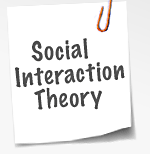

There are three candidates competing for the same position; one manager supports each of them. Social interaction theories help us to understand how the candidates present themselves in the interviews as well as how the vice presidents jockey for advantage while discussing the candidates.
Types of Social Interaction
- Cooperation occurs when people act together to promote common interests or achieve shared goals.
- The three hiring managers support different candidates, but are expected to cooperate to choose the best candidate
- Competition is a form of interaction in which individuals or groups may have conflicting goals, but they confine their conflict within agreed-upon rules of behavior.
- The job candidates compete with one another for the position but are expected to follow certain rules of behavior such as being honest in their interviews and in the resumes and other information they provide as part of the application process.
- The vice presidents making the hiring decision may also be in competition with one another to appear more competent and to strengthen their own position in the company. They may believe that their own status will be raised if the candidate they support gets the position.
Theories of Social Interaction - Role Theory
- Role theory focuses on the importance of social statuses and roles for social interaction.
- Statuses: are socially defined positions that people occupy.
- Statuses differ in their hierarchical relationships.
- president is the status with the highest prestige in this company.
- vice presidents have less prestige.
- Candidates have the least prestige in this process and can be most affected by the president and vice presidents.
- “candidate” is the manifest status (the most relevant status) of Jessica, John and Otis in this process.
- Vice President is the manifest status of Joe, Steve, and Sue.
- President is the manifest status of Richard.
- Latent statuses of the participants, such as their age, race, ethnicity, gender, and social class, also can affect the interaction.
- Roles: are the culturally defined rules for proper behavior that are associated with every status.
- Job candidates, Jessica, John, and Otis, are expected to behave in a manner appropriate for someone applying for a job and to give the interviewers plenty of opportunities to ask them questions.
- A candidate’s knowledge of the role expected of them in the job for which they are applying can be a big factor influencing whether they are hired.
- Role strain occurs when a single role has conflicting demands attached to it.
- The hiring managers may experience role strain if they believe it is too difficult to make a good decision. Candidates might experience role strain if they are not good at interviews or if they are not good at their job.
- Role Conflict occurs when two or more roles occupied by the same individual have inconsistent rules for behavior the person experiences role conflict.
- Jessica may experience role conflict between her role as “manager” and her roles as “wife” and “mother.”
Theories of Social Interaction - Social Exchange Theory
- Actions of each actor can have positive and negative consequences for the other actors
- The norm of reciprocity is a tendency for people to match the positive or negative acts of someone toward them with comparable positive or negative acts to the other. E.g., inviting someone over to your house is often followed by them inviting you to their house.
- The vice presidents discussing the candidates might attempt to influence each other by acknowledging good points made by each other in hopes of eliciting similar positive comments from the others.
Theories of Social Interaction - Dramaturgical Theory
- Dramaturgical theory views social interaction using the metaphor of the world as stage.
- Frontstage behavior is behavior in front of an audience the person wants to impress
- Backstage behavior occurs when one is among friends and does not have to try to impress them.
- Self-presentation in a frontstage setting is often aimed at impressing other people and making one’s self look favorable, perhaps even more favorable than one really is.
- For example, someone who did not want to support a candidate because of their gender, race, or ethnicity, might not want to say that openly. In that case they may speak in code, making vague references as to why they don’t support the candidate in order to convey a more positive impression of themselves. They are unwilling to speak clearly about their reasons because they are illegal or generally unacceptable to their audience.